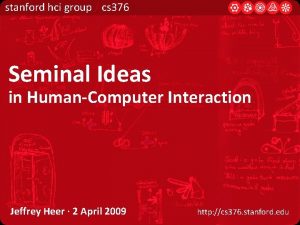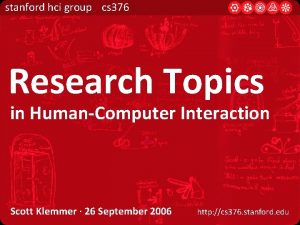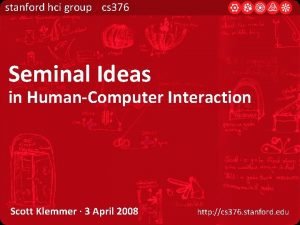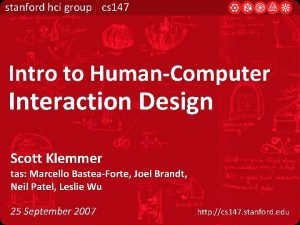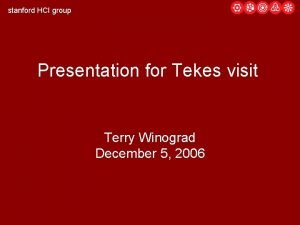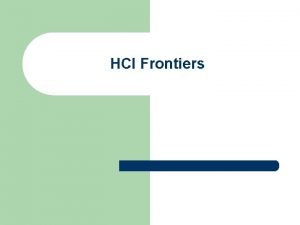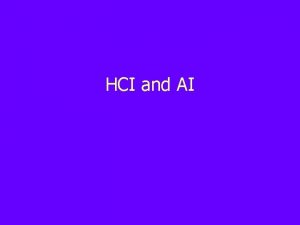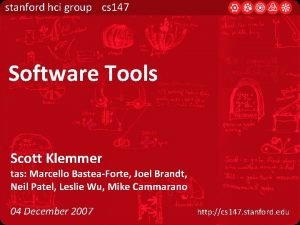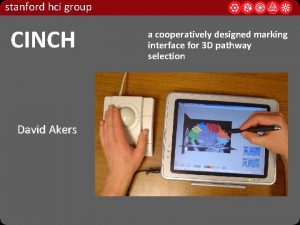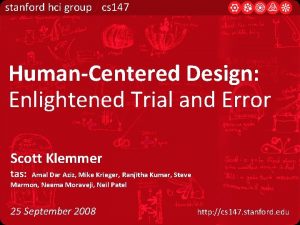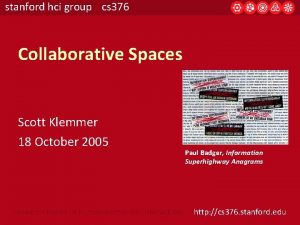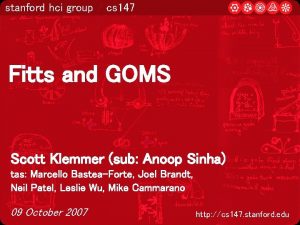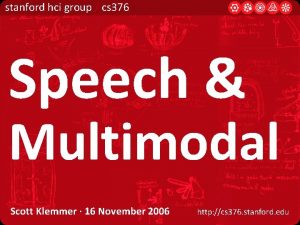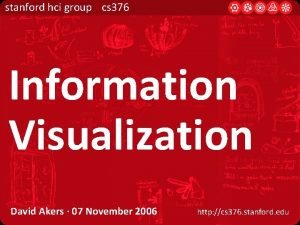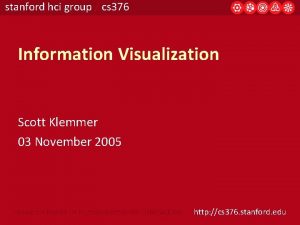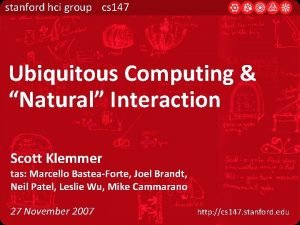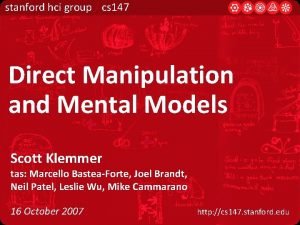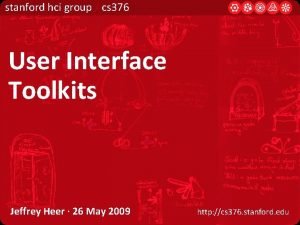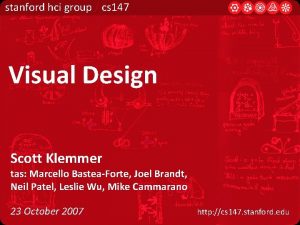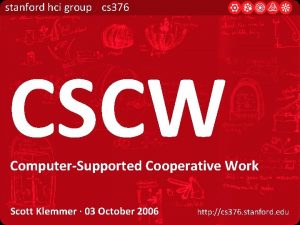stanford HCI group Presentation for Tekes visit Terry


























- Slides: 26

stanford HCI group Presentation for Tekes visit Terry Winograd December 5, 2006

stanford HCI group Beyond the Desktop: Interactive Workspaces (2001 -2004)

stanford HCI group Interactive Workspaces (2001 -2004) • Wallenberg Hall Experimental Classrooms

stanford HCI group Post. Brainstorm François Guimbretière

stanford HCI group Strategy • Imagine it is cheap and ubiquitous • Prototype Some prototypes • • • Interactive Tables Eye tracking Kinesthetic interaction Computer vision Causal visualization

stanford HCI group Tabletop Interaction • How is it different to work around a table?

stanford HCI group Multi-user Tabletop Interaction Merrie Ringel Morris

stanford HCI group

stanford HCI group GUIDE: Gaze-enhanced User Interface Design Manu Kumar • What if gaze detection were a cost-free non-intrustive added form of input for every display?

stanford HCI group Low cost prototyping

stanford HCI group Application Possibilities • • • Enhanced pointing and selection Task/Application switching Automatic adaptive scrolling Attention-based notification Gaze-contingent semantic zooming Gaze. Marks (bookmarks for what you’ve looked at)

stanford HCI group MIKS: Mobile Interaction using Kinesthetic Senses Taemie Kim How can our intuitive sense of body and limb position be used as a form of input?

stanford HCI group MIKS: Hardware – Tilt and orientation sensing st 1 prototype Proximity sensing

stanford HCI group The Vidget Gadget Dan Maynes-Aminzade • What if you had a low-cost low-complexity way to put vision-based systems into your everyday life?

stanford HCI group Using a Camera Doesn’t Have to be Difficult • Many of the standard computer vision techniques are easy to understand on a general level.

stanford HCI group Student Vidget Examples Virtual Mouse: Cursor Control by Fingertip Dancing Cat 20 Questions Using Nod Detection Drawing Caterpillars with Physical Objects Trigger for Text-to-Speech Privacy Protector

stanford HCI group Visualization of Causal Sequence Doantam Phan How can we make implicit causal connections directly visible?

stanford HCI group The d. school Learning Human-centered Design Thinking dschool. stanford. edu

stanford HCI group T-shaped people: Building both kinds of muscles

stanford HCI group Departments and Schools (so far) • Mechanical Engineering • Computer Science • Management Science and Engineering • Education • Business • Medicine (Biodesign)

stanford HCI group project based learning

stanford HCI group Design Process UNDERSTAND OBSERVE IMPLEMENT VISUALIZE EVALUATE PROTOTYPE

stanford HCI group Ignite – Solar Lighting for India http: //www. igniteinnovations. com/

stanford HCI group Some of the courses • • • Design for Extreme Affordability Creating Infectious Action Tools for Experience Design Clicks and Bricks Interdisciplinary Software – With Hasso Plattner, SAP – New ways of organizing software and access

stanford HCI group What’s Important • students engaged and confident in their innovation process • project based learning • radical collaboration • culture of prototyping • students as experts • integrating different faculty points of view

stanford HCI group
 Stanford hci group
Stanford hci group Stanford hci group
Stanford hci group Stanford human computer interaction
Stanford human computer interaction Stanford cs 147
Stanford cs 147 Stanford hci
Stanford hci Site initiation visit ppt
Site initiation visit ppt Kontinuitetshantering i praktiken
Kontinuitetshantering i praktiken Typiska novell drag
Typiska novell drag Tack för att ni lyssnade bild
Tack för att ni lyssnade bild Returpilarna
Returpilarna Varför kallas perioden 1918-1939 för mellankrigstiden
Varför kallas perioden 1918-1939 för mellankrigstiden En lathund för arbete med kontinuitetshantering
En lathund för arbete med kontinuitetshantering Särskild löneskatt för pensionskostnader
Särskild löneskatt för pensionskostnader Vilotidsbok
Vilotidsbok A gastrica
A gastrica Densitet vatten
Densitet vatten Datorkunskap för nybörjare
Datorkunskap för nybörjare Tack för att ni lyssnade bild
Tack för att ni lyssnade bild Debatt artikel mall
Debatt artikel mall Autokratiskt ledarskap
Autokratiskt ledarskap Nyckelkompetenser för livslångt lärande
Nyckelkompetenser för livslångt lärande Påbyggnader för flakfordon
Påbyggnader för flakfordon Formel för lufttryck
Formel för lufttryck Svenskt ramverk för digital samverkan
Svenskt ramverk för digital samverkan Jag har nigit för nymånens skära
Jag har nigit för nymånens skära Presentera för publik crossboss
Presentera för publik crossboss Argument för teckenspråk som minoritetsspråk
Argument för teckenspråk som minoritetsspråk
